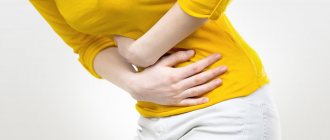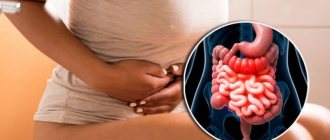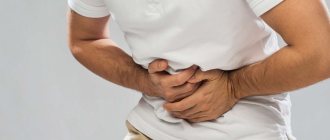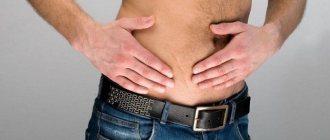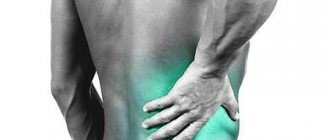Abdominal pain of any location in an adult or child should cause concern. The topographic center of this area is the navel. If your stomach hurts in the navel area, then this symptom is taken into account in the diagnosis to identify the cause.
The innervation of the organs located in the middle of the abdomen is provided by the solar plexus nodes, celiac and vagus nerves. At the same time, the branches go to the liver, gall bladder, stomach, and pancreas lying on the upper right. Therefore, irradiation into the umbilical region often accompanies signs of their pathology.
The loops of the small intestine are located in the central zone; analysis of the causes of pain should begin with diseases that directly affect this part of the gastrointestinal tract.
How to understand the nature of pain?
The doctor receives a description of the pain characteristics from the patient. Not everyone knows anatomy well, but even children can show themselves the most painful place. To find out why the stomach hurts in the navel area, you will have to answer questions about the intensity, radiation, time of pain, its connection with food intake, alcohol consumption, and heredity.
Sharp pain in the center of the abdomen indicates a condition that requires urgent action. An attack of a cramping nature can occur with biliary colic, strangulation of an umbilical hernia, urolithiasis, or perforation of an intestinal ulcer. Most often it spreads to the right hypochondrium, lower back, and groin.
As a rule, such abdominal pain around the navel can be associated with eating food and alcohol. They appear 2 hours or more after eating or at night after overeating heavy meat dishes, spicy seasonings, eating foods of questionable quality, and mushrooms.
The pain is accompanied by belching, heartburn, loss of appetite, and nausea. This is how the intestines react during irritation syndrome.
Severe pain in the middle of the abdomen is a possible sign of impaired blood flow in the mesenteric vessels. It occurs more often in older people as a complication after myocardial infarction. Caused by ischemia or thromboembolism of the arteries, in childhood it is called “abdominal migraine”.
The intense nature is typical for a malignant tumor, strangulation of an umbilical hernia. Irradiates and gradually shifts to the epigastric region. Aching constant pain occurs with intestinal bloating (flatulence), partial obstruction, atony, tumor growth, chronic inflammation (enteritis).
During the examination, the doctor palpates the entire abdominal area with gentle movements, carefully monitoring the patient’s reaction
Long-term pregnancy causes congestion in the pelvis, constipation, and a tendency to frequent urination. Pressure on the intestines disappears after childbirth. Reducing the volume of the abdomen in women leads to the restoration of normal functioning of organs.
Women in the 2nd-3rd trimester complain of a nagging pain around the navel. They depend on the stretching of the muscles and ligaments of the abdominal wall. More pronounced in primigravidas and in the absence of physical training.
Abdominal pain in the navel area is caused by increased intra-abdominal pressure. This mechanism occurs in patients with ascites (exudation of fluid due to cirrhosis of the liver), with a sharp rise in severity, and in coughing smokers.
When the pain is localized in the navel area, the doctor tries to feel the expanded muscle ring and the prolapse of the hernial sac when the patient strains. Observing a small child while crying allows you to visually identify an umbilical hernia.
Ovulation
During ovulation, many women experience pain associated with the rupture of the follicle and the subsequent release of the egg into the fallopian tube and then into the uterus. Pain in the lower abdomen is often felt only on the right or left, because the ovaries release only one egg per cycle, respectively, either the right or left ovary hurts. Ovulation usually occurs about 2 weeks before the expected start of the next cycle. Sometimes it is accompanied by spotting and increased vaginal discharge. Ovulation pain usually goes away within a couple of hours and is harmless and completely normal.
Localization Features
Pain near the navel does not necessarily remain in the central zone; it can shift, but be nearby. This relatively small area can be divided into parts for diagnostic specificity.
If your stomach hurts exactly in the middle, then you can think about an attack of appendicitis or an umbilical hernia.
The location just below the navel indicates the likelihood of Crohn's disease, ulcerative colitis, mesadenitis, small intestinal diverticulum, chronic enteritis, helminthic infestation, and endometriosis in women.
Abdominal pain in the navel area and slightly above is possible with an ulcerative process in the stomach and duodenum, duodenitis, bulbitis. A shift of maximum pain to the left of the navel is characteristic of pathology of the pancreas, accumulation of gases during atony of the large intestine.
The vermiform appendix is located to the right of the navel in an atypical position; an attack of appendicitis in such cases is difficult to diagnose.
With helminthic infestation, intestinal congestion causes obstruction
Ovarian cyst
An ovarian cyst is a benign, fluid-filled tumor located on the ovary. The ovaries release an egg every month during ovulation. Sometimes the follicle may not open or, for example, close again. In this case, the follicle fills with fluid and increases in size. Most cysts go away on their own, but sometimes, if they reach a significant size or become twisted, they can cause severe pain. Other symptoms: bloating, swelling, painful penetrative sex. Rarely, acute symptoms may occur: nausea, fever. In this case, you need to consult a doctor for advice.
What accompanying symptoms accompany pain?
Abdominal pain near the navel can be caused by spasm or stretching of hollow formations (stomach, gall bladder, intestines), signals from the capsule of parenchymal organs. In differential diagnosis, pain is considered in conjunction with other manifestations. We will present the most common pathology with typical symptoms.
Acute gastroenteritis
The body reacts with inflammation of the stomach and intestines to food poisoning, infection with pathogens of dysentery, cholera, salmonella, and a pathogenic strain of E. coli. Enteritis as an isolated lesion of the small intestine is rare.
For example, with helminthic infestation, after surgical interventions on the abdominal organs. Therefore, the course of enteritis begins with epigastric pain, repeated vomiting, dizziness, weakness, then persistent diarrhea (possibly with blood), pain around the navel.
When symptoms appear in several people who have eaten the same dishes, it is most likely to assume a foodborne illness. At home, you need to give enterosorbents to drink (activated carbon, Enterosgel, Smecta), drinking plenty of slightly acidified water is recommended.
If more than an hour has passed after eating, then there is no point in rinsing the stomach. To examine a doctor, you must call an ambulance.
Attack of acute appendicitis
The vermiform appendix is located in the initial part of the large intestine. Most people know to be wary of pain in the right iliac fossa. However, the anatomy of the appendix allows it to deviate significantly, “go” into the hypochondrium to the right, into the small pelvis and towards the center. Therefore, if your stomach hurts in the navel area, doctors try to confirm or rule out appendicitis.
The most characteristic signs:
- sudden onset with pain in the epigastric region;
- vomit;
- nausea;
- rise in temperature;
- weakness;
- after a few hours, the localization of pain moves to the navel or iliac region on the right, increasing in intensity;
- bloating;
- constipation;
- increased in position on the left side;
- positive symptoms of inflammation of the peritoneal layers.
Let us remind you what should not be done in such cases. It is strictly forbidden to: rinse the stomach and induce vomiting using home methods, apply a heating pad, or take general painkillers based on analgin.
These actions blur the symptoms and make diagnosis difficult. Warming up increases inflammation and brings the gangrenous form of the disease closer. The main measure is to quickly call an ambulance.
If the diagnosis of appendicitis is confirmed, treatment is only surgical
Umbilical hernia
More often detected in infants. The expansion of the muscle ring is associated with weakness and underdevelopment. In adults, formation is possible due to weakening of the muscular wall of the peritoneum, high pressure in the abdominal cavity and an enlarged abdomen (pregnancy, ascites with cardiac decompensation, cirrhosis of the liver, long-term hard work, previous surgery).
Why does my stomach hurt after lifting weights?
The protrusion under the skin is noticeable; a soft hernial sac is identified by palpation, which is reduced in the supine position when relaxed.
Severe pain occurs when pinched, when contracted muscles do not allow the contents of the sac to be reduced. Possible vomiting, flatulence, constipation. When part of the intestine is strangulated, the clinical picture of acute intestinal obstruction develops.
In most children, symptoms disappear by age three or earlier. Pediatricians recommend wearing a special bandage or patch. If strangulation develops, urgent surgical assistance is required.
The muscle ring is dissected, the condition of the intestines and mesentery located in the hernial sac is examined (if signs of necrosis appear, the damaged area must be removed), the hernia is reduced and the hole is sutured with plastic surgery of the abdominal wall.
Sign of dysbacteriosis
After long-term treatment with antibacterial drugs for various reasons, the balance of intestinal bacteria in a person is disrupted. This is manifested by pain in the intestines and diarrhea. Adults tolerate symptoms satisfactorily and can gradually restore the composition of the flora on their own. Children feel much worse.
The right solution is to take a course of probiotics and prebiotics. These are special products containing the necessary bifidobacteria and lactobacilli, as well as preparations to activate and support their growth.
When purchasing fermented milk products declared as “Biokefir”, we recommend paying attention to the production time. Bifidobacteria persist only in the first 2–3 days; subsequently, the product has no medicinal properties, retaining only its taste.
Crohn's disease
The appearance of periodic attacks of pain along the intestines in a teenager should raise suspicion of Crohn's disease. The peak incidence occurs between the ages of 12 and 18 years.
The entire digestive tract can be affected by Crohn's disease.
At the same time, the patient may experience bloody diarrhea caused by ulcers and cracks in the intestinal wall, bloating, and joint pain. Boys are more often affected. The child needs to be examined. Treatment is prescribed by a gastroenterologist.
Diverticulitis
Diverticula are saccular formations from a thinned intestinal wall. Their length varies from 5 mm to 15 cm. When they occur in the thin part, they give pain in the navel area. An infection gets into the diverticulum and causes inflammation.
The patient's temperature rises and signs of intoxication appear (nausea, headache). Formations do not disappear on their own. Inflammation is treated with antimicrobial agents, and if necessary, surgically.
Abdominal migraine
The name “abdominal” was given to migraine by analogy with headaches. The idea of local vasospasm is already a thing of the past. It has been established that both spastic and vasodilatory effects in certain areas are equivalent. The intestines are fed by arteries passing through the mesentery. Disruption of blood flow occurs due to spasm or delay of blood flow in arteries that have lost their tone.
The disease manifests itself as attacks of pain around the navel, lasting 30–40 minutes. It is detected in people at any age. It can begin in teenagers, which is associated with hormonal changes. Hereditary predisposition influences.
At the same time, the person feels nausea, diarrhea, and vomiting. People are more susceptible to emotional, nervous type, intensely experiencing stressful situations, overloaded with work. Treatment requires the intervention of a neurologist or psychologist.
Treatment
Help before diagnosis
Functional dyspeptic disorders can be successfully corrected by changing diet and lifestyle. If pain at the navel is combined with loose stools, you need to temporarily eliminate dairy products, fatty foods, and dishes with artificial sweeteners. The diet should consist of grain crops, stewed or boiled vegetables, lean meat and fish in moderation. It is important to avoid stressful activities.
If there are signs of food poisoning, first aid includes gastric lavage, if you have recently consumed low-quality food, and taking sorbents. It is necessary to drink more liquid (water, unsweetened dried fruit compote) to prevent dehydration of the body. With severe umbilical spasms and a sharp deterioration in health, the patient needs emergency medical care.
Conservative therapy
The treatment regimen is selected after identifying the root cause of peri-umbilical pain syndrome. Treatment is mainly carried out on an outpatient basis. Hospitalization is required for exacerbation of a chronic disease, a possible acute surgical condition, or severe dehydration. In gastroenterology, the following groups of drugs are used for pain in the peri-umbilical region:
- Enzymes
. Preparations of pancreatic enzymes improve digestion processes, eliminate the phenomena of malabsorption, due to which the pain syndrome disappears. For some combined pathologies of the intestines and stomach, in addition to enzymes, gastric juice is recommended. - Antispasmodics
. Most episodes of pain in the navel area are associated with spastic contractions of the intestines, which are successfully relieved by drugs with antispasmodic effects. For severe pain, analgesics are taken. - Probiotics
. Medicines normalize intestinal microflora and prevent bacterial overgrowth syndrome (SIBO). They are effective for a combination of pain and dyspeptic symptoms. To enhance the effect of probiotics, they are supplemented with prebiotics. - Antidiarrheal drugs
. For chronic diarrhea that is not corrected with diet, medications of the loperamide group are prescribed. They normalize gastrointestinal motility, slow down the movement of feces, and eliminate excessive peristaltic contractions and associated pain in the abdominal area.
The doctor selects a balanced diet that must be followed to prevent exacerbations of the disease. During the period of remission of chronic diseases, drinking mineral waters, physiotherapy methods, and sanatorium-resort treatment are recommended. In case of severe functional disorders of the gastrointestinal tract, it is advisable to conduct psychotherapy, which is aimed at eliminating the effects of stress factors.
Surgery
Pain in the navel area can be caused by surgical pathologies (appendicitis, intestinal obstruction), for which urgent surgical treatment is indicated. For uncomplicated forms of diseases in abdominal surgery, laparoscopic surgical techniques are used. Small intestinal obstruction and destructive forms of appendicitis require open surgery by laparotomy.
For hernias, various methods of hernioplasty are performed using mesh allografts and the patient’s own tissue to close the umbilical ring defect. Treatment of oncological processes involves an extended operation with resection of a section of the intestine and surrounding tissues as a single block, after which an intestinal anastomosis is formed or an enterostomy is removed.
Methods for diagnosing the cause of pain
Such a symptom as pain in the middle of the abdomen occurs in various diseases. The patient needs to identify the specific cause in order to know the optimal treatment and prevention measures. A general blood test reveals inflammation or allergies (leukocytosis, eosinophilia, increased ESR), signs of anemia or bleeding (decreased red blood cells, hemoglobin).
Examination of stool for scatology helps to establish the nature of the digestive failure (mucus, undigested particles, an abundance of fat, blood and leukocytes). Tank method Sowing establishes the cause of infectious enteritis and identifies dysbacteriosis.
A stool test for the Gregersen reaction (occult blood) is necessary for the early diagnosis of ulcer bleeding. If necessary, a test for helminths is carried out (scraping, smear). The X-ray method using a barium suspension reveals intestinal dyskinesia (spasm, atony), signs of obstruction, ulcerative changes in Crohn's disease, and deformation.
A video capsule is a device that allows you to examine all parts of the digestive tract within 8 hours. The recording shows the condition of the inner lining of the intestines, tumors, ulcers, scar changes. Magnetic resonance imaging and computed tomography are the most accurate external methods. They are not associated with radiation exposure and are painless for patients.
Each disease requires its own treatment methods. Drug therapy options do not always help. Many types of intestinal pathology have to be treated only with surgery. Patients themselves and those around them should be well aware that delaying access to a doctor leads to a worsening prognosis for treatment.
Menstrual cramps
During your period, levels of the hormone prostaglandin increase, which causes uterine contractions and shedding of the uterine lining (menstruation). Prostaglandins can also cause intestinal spasms, which can lead to pain, constipation, diarrhea and swelling. Nagging pain in the lower abdomen may appear several days before the start of menstruation, but after a couple of days the bleeding usually gradually weakens.
Despite the fact that this is the most common symptom during menstruation, if cramps prevent you from leading your usual lifestyle, you need to take a painkiller or antispasmodic. If the sensations are strong, then you need to go to the doctor to find out the cause. Warmth also helps with cramps: you can take a hot shower, bath, or place a heating pad on your stomach.
When to call a doctor
{banner_banstat9}
Fever and mild abdominal pain
- a reason to call a therapist at home. The reason for the arrival of an ambulance is severe, excruciating pain, which is accompanied by the following additional symptoms:
- Tight abdominal muscles.
- Urinary retention.
- Blood in vomit, feces, urine.
- Excrement in black.
- Temperature 38 °C and above.
- Uterine bleeding.
While waiting for the ambulance to arrive, you cannot take any medications, apply heating pads, or eat or drink. It is better to lie in a comfortable position and not make sudden movements.
Urinary tract infections and cystitis
Such infections can cause bloating, a feeling of pressure in the lower abdomen, and pain during penetrative sex. They are most often accompanied by frequent and painful urination. They are usually caused by a bacterial infection - E. coli. This bacterium is normal in the digestive tract, but it can infect the urethra and bladder. When the bladder is infected, the condition is called cystitis. If you suspect that you may have such an infection, you should contact your doctor to prescribe the appropriate antibiotic. Please remember that to prevent such infections, wipe urine with toilet paper only in the direction from the clitoris to the anus and do not wipe with the same piece of paper twice.
Pain syndrome in a child
Children more often experience psychosomatic pain from fear, anxiety, strong excitement or overexcitement. But the syndrome cannot be ignored, since discomfort in a child can be caused by serious diseases:
- intestinal colic;
- flatulence;
- dysentery;
- viral infections;
- intestinal dysfunction;
- lactose intolerance.
In newborns, the cause is colic, a change in the usual diet, a transfer from breastfeeding to formula or regular food. You can help with a heated warm towel or diaper. To relieve spasms, doctors prescribe safe medications. After consultation, it is permissible to use folk remedies, herbal decoctions, and compresses.
Pain syndrome is caused by intussusception, dyspepsia, pancreatitis, and obstruction. When the first symptoms appear, you should go to the hospital. If the pain intensifies, attacks become more frequent, then you can resort to self-help methods. So, for pain, drugs with a lower age threshold are allowed.
